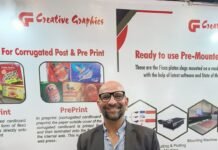After years of searching for a 3-D printing tech that is up to the challenge of sneakers, Adidas came upon a startup called Carbon Inc., which has raised $222 million to date. Instead of the plodding process of depositing plastic one layer at a time from a nozzle, Carbon’s “digital light synthesis” printers transform a liquid plastic into a solid using UV light and oxygen. This yields products comparable in quality to molded plastics at a competitive speed and cost, at least when making tens of thousands of a given object.
There are two very different examples of this milestone – one plastic, the other steel. There’s a running shoe from Adidas AG, with a 3-D-printed latticed sole that looks almost organic, like the exposed roots of a plant. Then there’s a steel hinge, indistinguishable from any other metal part except for incredibly fine striations in its surface, as if it had been deposited like sandstone rather than forged. In a feat impossible with conventional manufacturing, all three moving pieces of the hinge were crafted together. 3-D printing is more than two decades old, but to date the process has been limited to making novelties, prototypes, bits of machines for factories, or expensive specialized parts, like fittings for prosthetic limbs or fuel nozzles in jet engines.
By the end of 2017, the transformation of manufacturing will hit a milestone in the form of mass-produced printed parts. Until now, that concept was an oxymoron, since 3-D printing
has been used mainly for prototyping and customized parts. But the radical innovation of 3-D printing techniques means we are finally going to see some previously impossible designs
finding their way into our consumer goods. In the long term, it also means new products that previously would have been impractical to produce, and a geographical shift of some manufacturing closer to customers.











